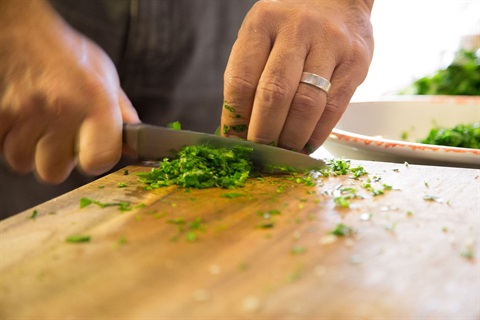Avoid Food Waste

Reducing Food Waste
Up to 40% of food is lost or wasted each year, according to data from the World Wildlife Fund. In the U.S., it's estimated that Americans lose more than $218 billion on wasted food.
Food waste is expensive, but purchasing decisions and proper food management at home can help you save money while being more environmentally sustainable.
What Can I Do?
At Home
- Plan menus for the week and prepare a shopping list for when you need to go to the store.
- Serve smart by managing portion sizes. Cook only what is needed for that meal.
- Understand date labels so you don't waste edible food based solely on the packaging dates. Use an app, such as USDA Foodkeeper, to manage food storage times.
- Save leftovers to eat within 3-4 days by storing them in portion-ready containers.
- Freeze ripe fruits and vegetables for baking, cooking and filling in gaps in recipes. You can also freeze uneaten leftovers to eat at a later date.
- Make one night a weekly “leftover night" to empty the refrigerator before shopping again.
- Track what you throw away; it will influence your next shopping trip.
At the Grocery Store
- Stick to your shopping list so you don't buy more than you need. Have a use in mind for every item you put in your cart.
- Match what you buy to the reality of your week. Ask yourself:
- How many meals am I eating at home this week?
- When do I need to make quick meals due to my schedule?
- Buy smaller quantities, if appropriate, to avoid spoilage and waste.
- Don’t shop hungry.
- If you bought items that you won’t use, donate them before their expiration date.
At Work
- If you bring a lunch, bring only what you will eat. If you brought too much, share with others.
- In case of leftovers, save them for the next day if you have a refrigerator on-site
Manage Food Scraps

In 2023, Arlington County collected an estimated 20-25% of available food scraps and compostable paper from our Residential Organics Collection Program, but roughly 4,100 tons of food scraps were sent to the Covanta waste-to-energy facility for incineration.
Composting food scraps to turn into valuable soil amendments is a preferable alternative to any type of disposal. Find more information about food scraps collection available to residential customers using the green organics cart.
Residents in multifamily buildings can drop off their food scraps at the Solid Waste Bureau (4300 29th St. South), or at one of 14 on-street collection bins outside select multifamily properties. Here's how it works:

- Download the Bigbelly Smart Compost app from the App Store or Google Play.
- The app will show the locations of on-street collection bins, their availability and what items are accepted.
- An unlock button will appear once you are within reach of the available bin. Tap the button to unlock the bin.
- Open the lid, toss your food scraps and close the lid. It’s that easy!
You can find the on-street composting bins at the following locations:
National Landing
Crystal Dr & 18th St S
Glebe Road
2910 S Glebe Road
Aurora Hills Library
735 18th St S
Culpepper Gardens
4500 block of N Henderson Rd
Quincy Park
Washington Blvd. & N Quincy St
Rosslyn
Clarendon Blvd. & N Pierce St
Wilson Blvd. & N Pierce St
Arlington Mill Community Center
909 S Dinwiddie St (near bus stop)
Ballston Metro Station
Fairfax Dr & N Monroe St
Fairfax Dr & N Stuart St
Ballston
Fairfax Dr & N Quincy St (NW corner)
Wilson Blvd & N Stuart St (SE corner)
Wilson Blvd & N Quincy St (NE corner, near Capital Bikeshare station)
Wilson Blvd & N Oakland St (SE corner bus stop)
 (PDF, 5MB)
(PDF, 5MB)
Downloadable PDF: On-Street Collection How-to and Acceptable Items(PDF, 5MB)
Additional Tips and Resources